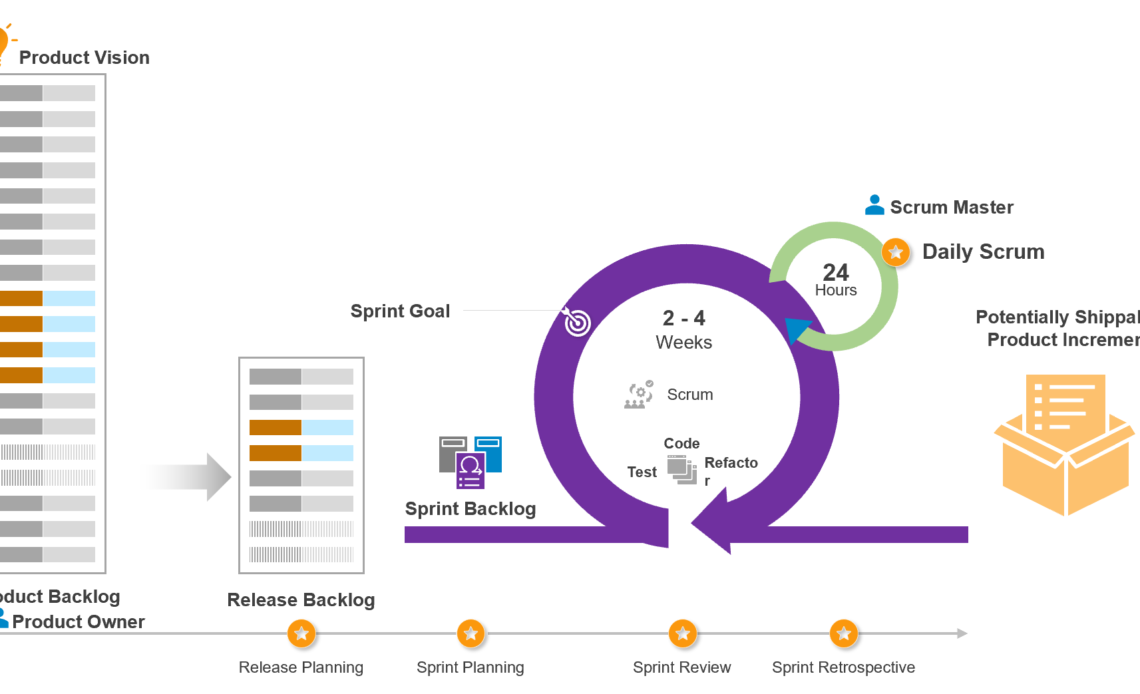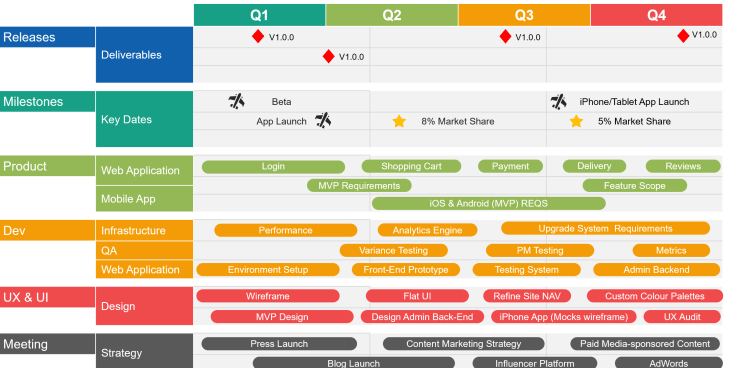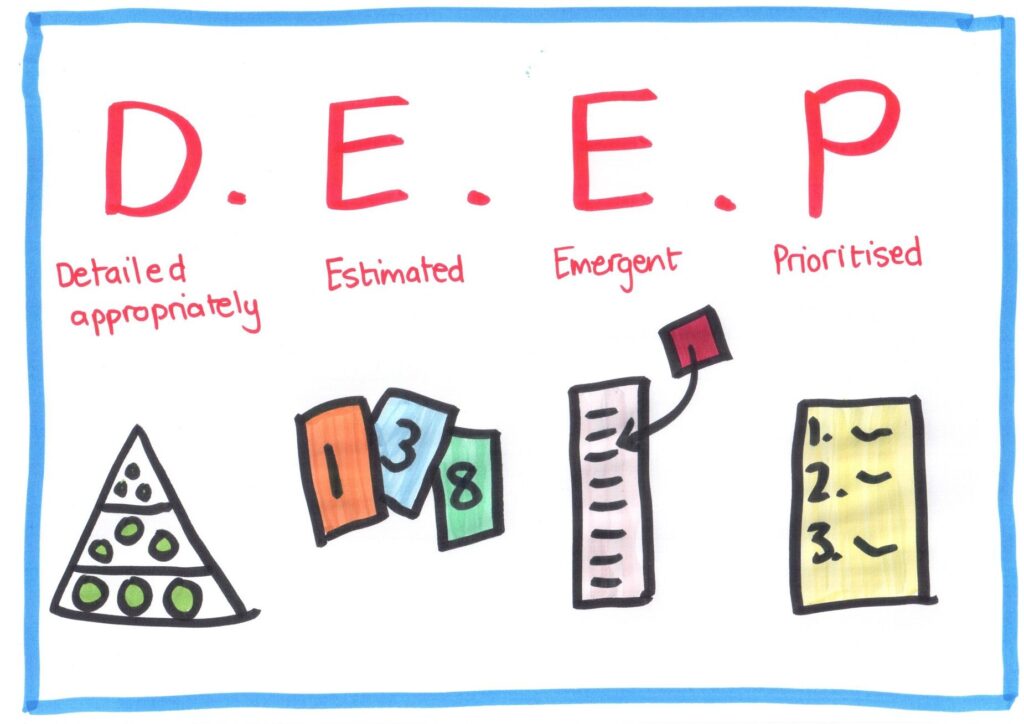
A Product Owner is responsible for maximizing the product’s value by prioritizing the requirements that provide maximum value and are an integral part of product development. They have several key roles and responsibilities right from product discovery through product development until maintenance. A Product Owner’s primary role is to act as a liaison between stakeholders and team, represent the customer and the business’s interest to the development team.
The value is in what gets used, not in what gets built.
Kris Gale
To understand the product owner’s role and responsibilities, we must first understand the Agile software development process and how a product owner fits into the whole agile model.
What is Agile?
Agile is the ability to create and respond to change. It is a way of dealing with, and ultimately succeeding in, an uncertain and turbulent environment.
What is Agile Software Development?
Agile software development is a set of methods and practices under which requirements and solutions evolve through the collaborative effort of self-organizing and cross-functional teams and their customer(s)/end user(s). It advocates adaptive planning, evolutionary development, early delivery, and continual improvement, and it encourages rapid and flexible response to change.
What is the Product Owner role in Agile Software Development?
Product owners maximize the value delivered by the development team by funneling in the most valued features based on the inputs from business users, customers, and other stakeholders while keeping in mind the alignment to product vision and technological landscape.
Product owners role is to work directly:
- With the designers to review the design items like mocks ups and wireframes from a usability perspective to make sure the feature is ready for the development team
- With the development team to understand the technical feasibility for implementing the feature
- With the testing team to verify the test plan and scenarios can validate and verify the acceptance criteria
- With scrum master to help resolve any constraint for the team to deliver.
In conclusion, it will be right to say that PO is the center of the development team, and while scrum master focuses on the team, a product owner mainly focuses on the team and customers and acts as a liaison between them.
What are the key role and responsibilities of Product Owner?
Below are the primary role and responsibilities of a product owner. We will see in detail what each of these responsibilities means.
- Own or contribute to the Product roadmap
- Own the product backlog
- Prioritize the needs and requirements coming from different stakeholders
- Oversee the product progress
1. OWN PRODUCT ROADMAP
A product roadmap is a visual summary representing the product’s high-level features and priorities, agreed upon with all the stakeholders, and aligned to the product vision.
Product owners’ responsibility is to own or contribute to the product road map and align the team and the stakeholders for a common goal throughout the development process. Product Roadmap helps product owners define the product backlog, and it pretty much drives the scrum.
In many organizations, product managers own the Product vision and program backlog while the product owner’s role is to contribute to the product vision and focus on the team backlog and execution.

2. OWN PRODUCT BACKLOG
One of the product owner’s primary responsibilities is to maintain and prioritize the product backlog for which the product owner can set up backlog grooming sessions. Product Backlog grooming session is essential to set priorities and align business and IT stakeholders on the product backlog’s top features, which will deliver maximum value. It helps to set the expectations on the immediate priorities for the team.
Product Backlog Items could be the User stories, defects reported, or any feedback from the end-user.
P.S. It is not the product owner’s responsibility to write user stories as per the scrum guide. They might write based on the work processes set in the organization. The product owner’s primary responsibility is to own and groom the product backlog and optimize the development team’s work.
What is role of Product Owner in Backlog Grooming Session?
Some of the activities done in the product backlog grooming sessions are
REFINE, RE-ASSESS, RE-PRIORITIZE
- Identify the top user stories the team will work on in the coming sprint.
- Split the user stories based on the effort estimation and technical dependencies by the team
- Clarify any questions of the dev team to help them understand and implement the user story
- Refine Ensure that the top user story meets the “Definition of Ready” and, if needed, update the details and acceptance criteria.
- Re-assess the existing user stories and remove the ones that no longer seem relevant
- Re-prioritize – Identify if there are any technical constraints and dependencies to implement the user story and accordingly re-prioritize
At the end of the backlog grooming the user stories should be DEEP.
- Detailed Appropriately – Top priority backlog items of the Product Backlog should be more fine-grained and detailed than the lower priority items.
- Estimated – Top priority backlog items should be estimated. And the lower priority items should be re-estimated with the current information.
- Emergent – Product backlog is always evolving based on product and business feedback. Backlog items are continuously added, removed, modified, and split to reflect the latest changes.
- Prioritized – Product backlog items are ranked in priorities, with the Highest priority item having more value than the lower priority item.

3. PRIORITIZE NEEDS (DIFFERENT KIND OF PRIORITIZATION TECHNIQUES)
The product owners’ role is to set the product priorities based on the feedback from different stakeholders (customers, internal stakeholders, and other POs). Product owners frequently add features, resolve bugs, and new enhancements related to the product as backlog items. It is essential to prioritize these features in alignment with the product vision, so the team and stakeholders clearly understand the work in focus. It will not be an overstatement to say that “Product owners are the face of the product.”
Product Owners can choose from numerous prioritization techniques to prioritize the backlog. Some of the common ones are Ranking, MoSCoW, Kano Model, Relative Weighting Prioritization Technique, etc.
MoSCow is the most commonly used one. It also integrates with DSDM, an agile framework – Dynamic Systems Development Method) It is practical and easy to run through with the stakeholders and consent for the priorities. Have explained in brief below :
MoSCoW (Must, Should, Could, Won’t)
- Must Have non-negotiable Requirement gets the topmost priority
- Should Have– Important Requirements adds value, though not mandatory
- Could Have – Requirement that is nice to have, have less impact
- Won’t Have – Requirements which will not be worked upon, not a priority for the specific time frame
4. OVERSEE THE PRODUCT PROGRESS
One of the key responsibilities of the product owner is to track the product’s progress during the iterations and give feedback whenever the development team misses the quality and deliverable’s timeline.
To ensure the development team is building the product right, the product owner accepts the user stories based on the acceptance criteria defined and makes sure that the user stories implemented meet the “Definition of Done.” If the Product owner rejects, the user story development team might need to add more tasks to satisfy the acceptance criteria.
What is role of Product Owner in daily scrum?
Product Owners can be part of the daily scrum to get early feedback on the scope and day-to-day team capacity, but they should be more like observers and listeners. Product owners might be asked some follow up questions from the team at the end of the standup to clarify some aspect of the user stories, but it should be brief and should not derail the focus of daily scrums.
Agile Software development from PO perspective.
To understand the whole process, i would recommend watching this video by – Henrik Kniberg
Drop a line if there is a specific topic or discussion you would like to have.Let me know your thoughts and do share your experience.
Learn Innovate RISE & SHINE
LinkedIn – https://www.linkedin.com/in/akansham/
Twitter – https://twitter.com/_iDesire_